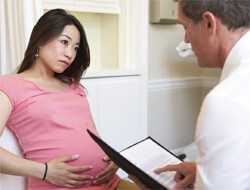Get tested for group B strep (GBS)

Talk to your healthcare provider about the test for GBS.
Print-friendly Version
Español [2 pages]
If you are pregnant, talk with your doctor or midwife about getting a group B strep (GBS) test when you are 35–37 weeks pregnant.
If you have GBS, your baby can get very sick and even die if you are not tested and treated.
"I talked with my doctor and made a plan for labor. It helps put my mind at ease to be prepared."
Your action plan for keeping your baby safe from GBS
| Before 35 weeks | If you think you might have a C-section or go into labor early, talk with your doctor or midwife about making a GBS plan. |
|---|---|
| At 35 to 37 weeks (your ninth month of pregnancy) | Talk with your doctor about getting tested for GBS. If you test negative for GBS, you don’t need to do anything more. |
| IF YOU TEST POSITIVE |
When your water breaks or when you go into labor
|
| If you go into labor, or your water breaks, but you haven’t had the GBS test | Remind the staff that you have not had a GBS test. |

If you tested positive for GBS, you will need to get to the hospital right away when your water breaks or you go into labor.
Frequently asked questions about GBS and the GBS test
What is GBS?
It is a common type of bacteria. GBS is often found in the vagina and rectum of healthy women of all races and ethnicities. In fact, about 1 in 4 women in the United States carry this type of bacteria. These bacteria can come and go naturally in the body.
If you have GBS bacteria in your body, you would not feel sick or have any symptoms. GBS is usually not harmful to you. Other people in the house, including kids, are not at risk of getting sick from GBS.
GBS can be passed on to babies during childbirth, and that’s dangerous for them.
What is the GBS test?
This a test that is recommended for all pregnant women to get at 35–37 weeks to find out if they have GBS bacteria in their body.
Should I be tested for GBS before I am 35 weeks pregnant?
The GBS test is recommended between 35–37 weeks of pregnancy. If you think you might go into labor early, talk with your doctor or midwife about making a GBS plan.
Is there any risk to getting the GBS test?
There are no risks to being tested for GBS.
How does the doctor or midwife do the GBS test?
The test is an easy swab of the vagina and rectum that should not hurt.
What does it mean to “test positive” for GBS?
If you test positive, that does not mean you have an infection. It only means that you have these bacteria in your body. Testing positive for GBS does not mean that you are not clean. It does not mean that you have a sexually transmitted disease. The bacteria are not spread from food, sex, water, or anything that you might have come into contact with.
I tested positive. Why isn’t my doctor or midwife giving me antibiotics immediately?
The antibiotic is only given during labor — you do not need to worry about getting it before you go into labor. Taking the medicine before you begin labor does not prevent the bacteria from spreading to your baby during childbirth. This is because the bacteria can grow back very fast.
How will my doctor or midwife protect my baby?
You will get antibiotics during labor by IV (through the vein).
Your baby’s doctor will check on the baby once he or she is born. The baby likely won’t need extra antibiotics or other medicine after birth, unless the doctor tells you that they are needed.
Will I need a GBS test only for my first pregnancy, or for every pregnancy?
Each time you are pregnant, you need to be tested for GBS. It doesn’t matter if you did not have this type of bacteria before — each pregnancy is different.
Can I breastfeed if I tested positive for GBS?
Yes, women who test positive for GBS can breastfeed. Rarely, GBS can be spread to babies through breastmilk, but the benefits of breastfeeding are much greater than the risk of spreading GBS.
Top of PageFor More Information
- Talk to your doctor or nurse if you have any questions.
- Find more information on the GBS website.
- Page last reviewed: December 8, 2015
- Page last updated: July 20, 2016
- Content source:




 ShareCompartir
ShareCompartir